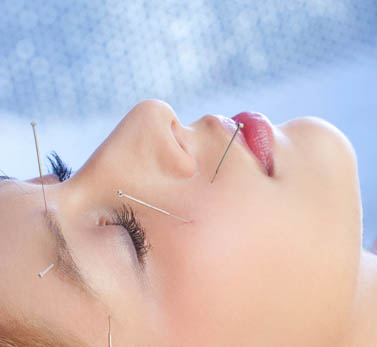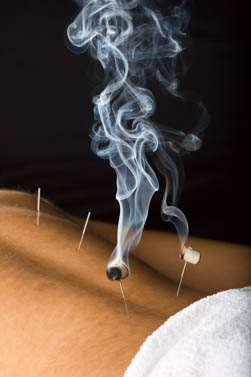Acupuncture relieves nasal congestion due to rhinitis. Research published in the Shanghai Journal of Acupuncture and Moxibustion demonstrates that acupuncture combined with moxibustion alleviates nasal congestion, swelling, post-nasal drip, and a runny nose.  The research confirms that acupuncture exerts an anti-inflammatory action, enhances immunity, and is effective in the prevention of immunological related disease.
The research confirms that acupuncture exerts an anti-inflammatory action, enhances immunity, and is effective in the prevention of immunological related disease.
The research compared the effectiveness of acupuncture plus moxibustion with nasal drops containing nitrofurazone and ephedrine. The total effective rate of the nasal drop medication was 55%. Acupuncture combined with moxibustion achieved an 85% total effective rate for the alleviation of rhinitis signs and symptoms.
The Traditional Chinese Medicine (TCM) principles chosen for the acupuncture point selection were to promote blood circulation, remove stasis, and open nasal passages. Acupuncture was applied to acupoints:
- M-HN3, Yintang
- DU20, Baihui
- DU4, Mingmen
- LI20, Yingxiang
- GB20, Fengchi
- LI4, Hegu
Manual stimulation using the bu-pushing technique was applied to the acupuncture needles to elicit a deqi response at the needle site. Total needle retention time was thirty minutes per acupuncture session. Moxibustion was applied to acupoints DU4, Yintang, and GB20 during needle retention. Additional moxibustion along the acupuncture meridians was applied for an additional one minute. Acupuncture and moxibustion were applied once per day for one week.
The acupuncture plus moxa group was compared with the medication group receiving the nasal drops containing nitrofurazone and ephedrine. Three to five drops were applied two times per day for the one week treatment period. The nasal drops achieved a 55% total effective rate and acupuncture plus moxibustion achieved an 85% total effective rate.

Oral Ulcer Prevention
Another research team discovered that acupuncture benefits the immune system and prevents oral ulcers. Li et al. examined patients with chronic recurrent oral ulcers and applied acupuncture therapy using the following acupoints:
- ST4, Dicang
- ST6, Jiache
- ST36, Zusanli
- LI4, Hegu
Additional acupuncture points were added based on differential diagnostics. Patients were diagnosed with accumulation of heat in the heart and spleen upon presentation of a high number of oral ulcers with significant swelling, thirst, halitosis, constipation, excessively yellow urine, a red tongue with a yellow coating, and a rapid pulse. The following acupoints were added for patients with this diagnosis:
- PC8, Laogong
- HT5, Tongli
- SP6, Sanyinjiao
Another group received a different set of supplementary acupuncture point needling with the diagnosis of yin deficiency heat. These patients had between one and three oral ulcers, minor swelling, painful ulcers, dry mouth, a feeling of excessively warm limbs and chest, a red tongue with a diminished coating, and a rapid pulse. The following acupoints were added for these patients:
- KD6, Zhaohai
- SP9, Yinlinquan
A third differential diagnosis of qi and blood deficiency was made if patients had few oral ulcers, absence of swelling, lack of thirst, fatigue, loose stool, aversion to cold, a pale tongue with a thin coating, and a weak pulse. The following acupoints were added for these patients:
- CV4, Guanyuan
- CV6, Qihai
Follow-up exams were taken at three months, six months, and one year after acupuncture treatment. The results demonstrated that acupuncture therapy reduced oral ulcer relapse rates by 71.70%. Acupuncture also reduced pain levels and the total number of oral ulcers. In a measurement of immunological responses, the researchers discovered that acupuncture had a direct regulatory effect on T lymphocytes.
References:
Fan, X. H. & Xie. Q. (2015). Therapeutic Observation of Acupuncture-moxibustion for Chronic Simple Rhinitis Due to Yang Deficiency. Shanghai Journal of Acupuncture and Moxibustion. 34 (7).
Chen, R. X. (2007). To mediate the regulatory effects of moxibustion on human body functions with acupoint thermal sensitization. Journal of Jiangxi Medical College. 19(1): 57-60.
Tao, H. M, Wei, X. F., Xie, Q., et al. (2011). Clinical Treatment of Allergic Rhinitis using Xie’s Wenduqumai acupuncture treatment. Journal of Chinese Folk Medicine. 20(12): 138.
Li, J. H. & Xu, C. M. (2014). The effects of acupuncture on T lymphocyte subsets in patients with recurrent oral ulcer. Journal of Practical Stomatology. 30 (6).
Liu, Q. M. (2012). Oral Diseases 4th Edition. People's Health Publisher. 59-60.

